#SoftwareDesign
Explore tagged Tumblr posts
Text
Automated Guest Check-in: How Kiosk Machines Improve Security in Gated Communities

In today’s rapidly evolving digital landscape, gated communities are increasingly turning to smart technology to improve security and operational efficiency. One of the most transformative innovations in this space is the automated guest check-in kiosk. These kiosks are revolutionizing how visitors are managed, ensuring a seamless, secure, and user-friendly process. As the demand for convenience and heightened security grows, the adoption of automated guest check-in kiosks is becoming a common trend across residential complexes, luxury apartments, and private housing communities.
#web development#design#softwaredesign#Software#Technology#Productivity#programming#Business#Marketing#Kiosk#Kiosk machine#Self service
2 notes
·
View notes
Text
CPE312 - Software Design and Engineering
Class Discussion + Group Activity
September 19, 2024
WEEK 6
ִֶָ𓂃 ࣪˖ ִֶָ🐇་༘࿐
Today, our instructor discussed about Software Testing and Quality Assurance. Although I was a bit sleepy during the lecture, I managed to catch a few important parts of the discussion. We learned about different testing methods like Black Box and White Box Testing, and John Brooke's System Usability System (SUS). Our instructor also discussed Regression Testing, which checks if changes in the software create new problems, and System Testing, which ensures that the whole program works properly before release.

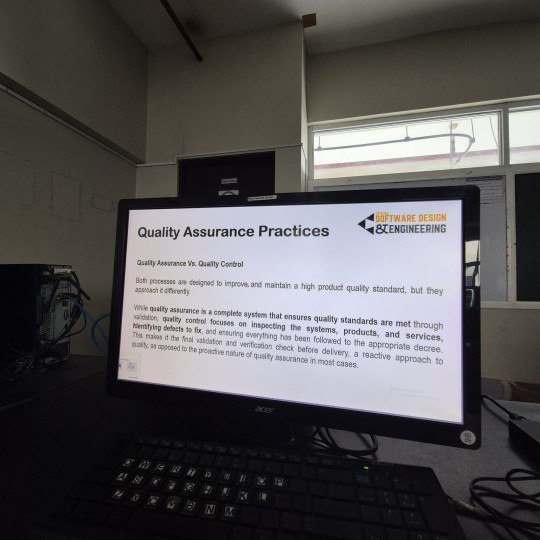
After the lecture, we had our group activity where we analyzed UI (User Interface) problems. Our group included Sean Quincy Manquilimotan and Earl Cagaanan as note-takers, while John Raynier Tejano and I focused on discussing the issues in the UI design. We looked at problems users might face, like unclear layouts or confusing buttons, and tried to come up with ways to improve the overall experience.

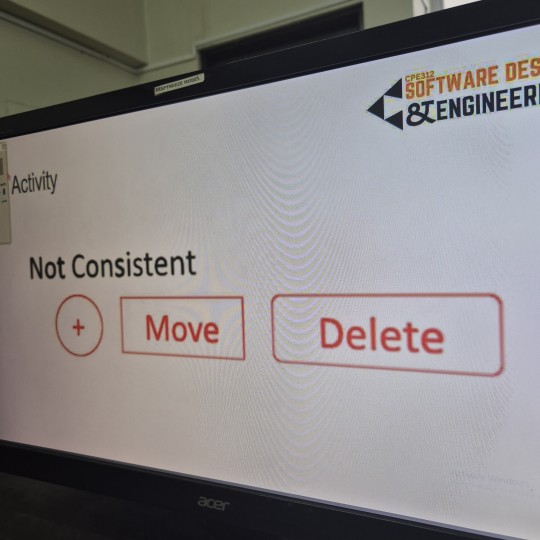

We were also given another task involving John Brooke’s System Usability Scale (SUS). This scale helps measure how easy or hard it is to use a system by asking 10 questions. Each question is rated from 1 to 5, and after calculating the responses, we get a score that tells us how good the usability is. A higher score means better usability. To calculate it, you subtract 1 from the odd-numbered questions' answers, subtract the even-numbered questions' answers from 5, and then multiply the total by 2.5 to get a score out of 100.


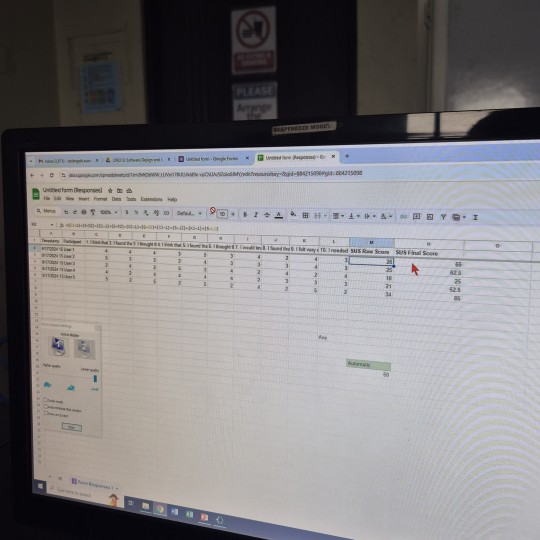
For this task, Tejano worked on solving the SUS with responses from 3 participants through google forms and google spreadsheets, while I did it manually. We added up all the scores, divided them by 3 (since there were 3 participants), and this gave us the average score, showing how usable the system was overall.
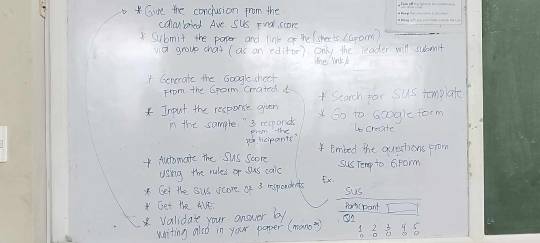
I really enjoyed the activity because we worked as a team and made sure no one was left behind. Everyone’s opinions were welcomed, and we didn’t have any arguments. I hope that when we work on our EduConnect TutorHub software, we can use the same strategy we showed today—doing teamwork and everyone participates.
ִֶָ𓂃 ࣪˖ ִֶָ🐇་༘࿐
#CPE3C#SDE#3rdYear#College#SoftwareDesign#JohnBrooke#SUS#ScalabilityUsageSystem#SoftwareTesting#QualityAssurance
2 notes
·
View notes
Text
September 5, 2024 *ೃ༄
During the fourth week of Software Engineering and Design, we had an in-depth discussion about Software Design and its significance in system development. We also discussed about the different design patterns, and things to consider when programming the system design.
Furthermore, we were also grouped randomly for a collaborative task regarding the discussion. For our group, we were given a scenario about a designing a system for collaborative document editing. To us, it sounded similar to programs like Canva or Google Docs. For the activity, we defined the core functionalities of the system, recommended design patterns that fit the features of the system, and sketched an initial system design. Then, we were tasked to analyze the work of the opposite group and see whether their recommended design patterns worked for their system or if it didn't.
In conclusion, I have learned a lot about software design and its value to a system project, and I also learned more about collaborating with other people with limited time budget.
That's all for the fourth week! ✧ ˚ · .




2 notes
·
View notes
Text
Tailored for Impact: How Custom Application Development Transforms Ideas into Results

In today’s fast-paced digital economy, having a great idea isn’t enough — what matters is turning that idea into a functional, impactful application that delivers value. Whether you're a startup founder, a small business owner, or a corporate innovator, custom application development could be the edge you need to outperform the competition.
Why Custom Applications?
Let’s face it: generic, off-the-shelf software only takes you so far.
It’s like buying a one-size-fits-all outfit — it might work, but it won’t fit like it was made for you.
Custom application development is exactly that: tailor-made software designed to solve your business problems, reflect your brand values, and scale with your goals.
Key Benefits:
Precision: Address your exact needs without unnecessary features.
Scalability: Grow and evolve the app as your business expands.
Integration: Seamlessly connect with your existing systems.
Security: Implement custom security protocols tailored to your data sensitivity.
Competitive Advantage: Build something your competitors can’t easily replicate.
From Spark to Software
Creating a successful application isn’t just about writing code. It’s a journey — a collaborative process that turns a raw concept into a powerful digital tool.
Here’s what that looks like:
1. Discovery & Planning
Every great app starts with understanding.
At this stage, your development partner dives into:
What your app needs to do
Who your users are
What your goals look like in 6–12 months
What existing tools or systems the app should connect with
Deliverables: Scope, requirements document, user journey map.
2. UX/UI Design
Before a single line of code is written, the design team creates wireframes and mockups to:
Visualize the app’s layout
Optimize user flow
Ensure accessibility and responsiveness across devices
Deliverables: Wireframes, visual design prototypes.
3. Agile Development
Using frameworks like Agile or Scrum, developers start building the application in sprints. This allows for:
Frequent feedback loops
Rapid adjustments
Early testing
Common tech stacks include:
Frontend: React, Angular, Vue
Backend: Node.js, Django, Laravel
Database: PostgreSQL, MongoDB, Firebase
DevOps: Docker, Kubernetes, AWS, Azure
Deliverables: Fully functioning modules, tested iteratively.
4. Quality Assurance
QA teams test the app across devices, operating systems, and network conditions. They look for:
Bugs & crashes
Security vulnerabilities
Performance bottlenecks
UI/UX inconsistencies
Tools like Selenium, Appium, and Postman are commonly used.
5. Launch & Post-Launch Support
After rigorous testing, your app goes live — but the journey doesn’t end there. Ongoing support includes:
Monitoring uptime and server loads
Rolling out updates
Fixing issues based on real user feedback
Scaling features based on usage patterns
Real-World Use Cases
1. A Local Retailer Builds a Mobile App
A brick-and-mortar store struggling with foot traffic created a custom mobile app for loyalty rewards and online ordering. The result? A 30% increase in repeat customers and 2x online sales in six months.
2. An HR Tech Startup Launches an MVP
Instead of building a massive HR platform right away, a startup partnered with a development team to launch a Minimum Viable Product (MVP) — just enough to attract investors and test the market. After a successful seed round, the app was scaled with advanced features.
3. Enterprises Automate Internal Workflows
Manual processes like expense tracking and employee onboarding can be transformed with custom web apps. One enterprise saved over 1,000 employee hours per year by automating these with a secure internal platform.
Who Needs Custom Application Development?
If you're wondering whether this is the right fit for you, ask yourself:
Do I need something that doesn't exist yet?
Is my business held back by off-the-shelf tools?
Do I want to automate or digitize specific processes?
Am I trying to create a unique digital experience?
If you answered “yes” to any of these, custom development is worth exploring.
Ideal for:
✔️ Startups ✔️ SaaS platforms ✔️ E-commerce stores ✔️ Healthcare systems ✔️ Logistics & supply chain apps ✔️ Educational tools & e-learning platforms
Tools & Technologies in Use Today
CategoryPopular ToolsFrontendReact, Angular, FlutterBackendNode.js, Python, Ruby on RailsMobileKotlin (Android), Swift (iOS), React NativeDatabaseMySQL, MongoDB, FirestoreDevOpsDocker, Jenkins, AWS, AzureAI & MLTensorFlow, OpenAI APIs, LangChain
conclution : Custom Apps Are the Future of Smart Business
In a world where businesses are racing to innovate and differentiate, custom application development isn’t a luxury — it’s a strategic necessity. Whether you're solving a niche problem, improving internal efficiency, or delivering unique customer experiences, custom software helps you do it your way.
Instead of forcing your workflow to fit a generic tool, you get software that adapts to you, scales with you, and evolves as your vision grows.
So if you're holding onto an idea that could change how your business operates or how your users engage now’s the time to build it.
#customappdevelopment#startuptech#businessapps#tumblrtech#appdevelopment#softwaredesign#fromideatoapplication#buildyourapp#webapps#mobileapps#techforbusiness
0 notes
Text
The Real Power Behind Every Smart Business: Software Development Services

In today's fast-paced world, where businesses are becoming more digital by the day, software development isn't just a tech task—it's the very engine that drives innovation, efficiency, and long-term success.
Whether you’re running a startup, managing a growing enterprise, or exploring new opportunities in technology, understanding how software development services work—and what they offer—is now more important than ever.
What Exactly Is Software Development?
Let’s keep it simple. Software development is the process of creating digital tools—web apps, mobile apps, desktop software, AI integrations—that help businesses run smoother, faster, and smarter.
But it’s more than just coding.
It’s about solving real-world problems through digital solutions.
From automating mundane tasks to building large-scale platforms, today’s businesses rely on custom-built software tailored specifically for their needs.
Why Businesses Are Turning to Local Talent in Delhi NCR
Over the past few years, the demand for software development services in Delhi NCR has exploded. Why? Because companies are starting to realize that having local experts brings better communication, stronger collaboration, and a better understanding of the business environment.
It’s not just about saving costs—it’s about building solutions that actually work, without long delays or miscommunication.
This is where working with a software development company in Delhi NCR becomes a smart choice. With a pool of highly skilled developers, user-focused designers, and agile teams, these companies offer world-class services while staying grounded in practical business needs.
The Role of AI in Today’s Software Landscape
AI is no longer the future—it’s the present.
More companies are investing in AI software development services in Delhi NCR to stay ahead of the curve. From chatbots to predictive analytics and intelligent automation, AI-based tools are helping businesses make smarter decisions, faster.
Whether you’re in e-commerce, healthcare, education, or logistics, there’s a strong chance AI can bring real value to your operations.
And with AI talent growing across India, especially in tech-forward regions like Noida and Delhi NCR, tapping into local expertise is easier than ever.
Noida’s Rise as a Tech Hub
Once known for its industrial areas, Noida has evolved into one of the most vibrant tech ecosystems in the country. It’s now home to many of the top software companies in Noida that are not only building software for India—but for the world.
These companies are known for blending deep technical knowledge with practical business strategy. And whether you're a startup looking for a Minimum Viable Product (MVP) or an established brand in need of scalable architecture, Noida’s software scene has something for everyone.
What Makes a Software Developer “The Best”?
When people look for the best software developers in Delhi, they’re not just looking for someone who can write code. They want problem solvers. Thinkers. Builders who understand how to translate business goals into functioning, reliable software.
Here’s what sets great developers apart:
They ask the right questions before writing a single line of code.
They communicate clearly and keep you in the loop.
They use modern, secure technologies and build with scalability in mind.
They test thoroughly and stand by their work long after delivery.
Finding the right team means more than checking credentials—it’s about trust, transparency, and shared vision.
What Should You Look for in Software Development Services?
If you're planning to partner with a software development company in Delhi NCR, here are a few signs you're on the right track:
They take time to understand your business goals.
They offer customized solutions—not one-size-fits-all packages.
They focus on user experience and performance.
They are open about costs, timelines, and technology stacks.
They stay updated with current trends, like AI, cloud computing, and cybersecurity.
Whether you're building a customer-facing app or an internal management tool, it's all about aligning the software with your long-term strategy.
Final Thoughts
Software development isn't just for tech companies anymore.
It’s for every business that wants to stay competitive, deliver value faster, and adapt to changing times.
As businesses across industries go digital, investing in reliable, tailored software development services in Delhi NCR could be the difference between keeping up—or leading the way.
Whether you’re exploring AI software development services in Delhi NCR or searching for the top software companies in Noida, the resources and talent are already here—you just need the right direction.
So, before you outsource overseas or settle for cookie-cutter tools, take a deeper look at what local development can offer. The right software won’t just help your business run better—it might just help it thrive.
#softwaredevelopment#NoidaTech#DelhiDevelopers#customsoftware#AIinBusiness#softwaredesign#DigitalSolutions
0 notes
Text
Mastering Unit Testing: Essential Strategies for Modern Software Development
In the world of software development, unit testing is no longer optional — it's a necessity. As applications grow more complex, testing individual units of code ensures reliability, reduces bugs, and boosts confidence in your codebase.
What is unit testing in software testing?
Unit testing involves testing individual components of a program in isolation, ensuring each part functions as expected. By focusing on the smallest testable units (functions or methods), developers catch issues early, preventing them from snowballing into bigger problems.
The Evolution of Unit Testing:
Unit testing has shifted from a secondary consideration to a central part of the development process. It’s the foundation for creating scalable, maintainable, and reliable applications. Without it, teams risk costly production bugs and lost reputation.
Building a Robust Testing Strategy:
Testing Pyramid: Focus on a broad base of unit tests (70-80%), fewer integration tests, and minimal end-to-end tests to maintain speed and maximize coverage.
Test-Driven Development (TDD): Write tests before code. This improves design, ensuring your code is always testable and aligned with requirements.
Meaningful Test Cases: Don’t just test the happy path; test edge cases, error handling, and unexpected inputs for comprehensive coverage.
Advanced Unit Testing Techniques:
Mocking & Stubbing: Control external dependencies to test units in isolation.
Parameterized Testing: Run the same test logic with different input values to reduce duplication.
Property-Based Testing: Automatically generate random test cases to uncover edge cases you might miss.
Measuring Testing Effectiveness:
Code Coverage: Aim for high coverage, especially on critical business logic.
Mutation Testing: Check if your tests are catching bugs by deliberately introducing errors into the code.
Performance Testing: Set performance benchmarks for individual components to catch regressions early.
Common Pitfalls to Avoid:
Over-Testing & Under-Testing: Balance test coverage to avoid maintenance overhead while ensuring critical code paths are well-tested.
Brittle Tests: Make sure tests are resilient to minor code changes.
Test Data Management: Use test data builders and fixtures for reliable, repeatable tests.
Integration with Modern Development Workflows:
Continuous Integration: Automate unit tests within your CI pipeline to ensure code stays reliable.
IDE & Tooling: Leverage modern IDEs and test runners for efficient and seamless testing.
Team Collaboration: Make unit testing a team practice with shared knowledge and test reviews.
The Future of Unit Testing:
AI-Powered Test Generation: AI tools can help auto-generate unit tests, though human insight remains essential for comprehensive coverage.
Cloud-Native Testing: Unit testing must adapt to handle distributed systems and microservices as apps move to cloud environments.
Unit testing isn't just a practice; it’s a skill that separates professional developers from amateurs. By mastering it, your software will be more reliable, maintainable, and agile.
For teams looking to elevate their testing strategies, Keploy offers innovative solutions that streamline the testing process, ensuring comprehensive testing is more accessible than ever.
#UnitTesting#SoftwareTesting#TestDrivenDevelopment#TDD#TestAutomation#DeveloperTools#SoftwareDevelopment#CleanCode#TestingBestPractices#CodeQuality#Mocking#ContinuousIntegration#SoftwareEngineering#AgileDevelopment#PerformanceTesting#CI#TestCoverage#SoftwareDesign#TechTools#Keploy#DevelopmentStrategy#Debugging#TestStrategies
0 notes
Text

💡 Looking for expert custom software development in Dubai?
Risians Technology builds tailored software solutions for startups, SMEs, and enterprises — including ERP systems, CRMs, web apps, and mobile platforms.
We focus on smart automation, user-friendly design, and scalable performance to help businesses across the UAE grow faster and work more efficiently.
🚀 From idea to launch, we turn your vision into code.
🔗 Explore our services
#CustomSoftwareDevelopment#SoftwareDevelopmentDubai#RisiansTechnology#WebAppDevelopment#ERPSoftware#CRMSystems#BusinessSoftware#DubaiStartups#TechCompanyDubai#MobileAppDevelopment#SoftwareDesign#UXUIDesign#UAEBusiness#AutomationSolutions#DigitalTransformation
0 notes
Text
18TH WEEK
On this day June 4 2025, Our final presentation. During this day we presented our system to the teachers. We perform it well but some of the functionality of our system is not working well and we did find some things that we did not include in our system.
After the presentation the teachers instructed us to do some more work in our system so that it fully functions. After that we took some pictures and said thanks to the teachers.
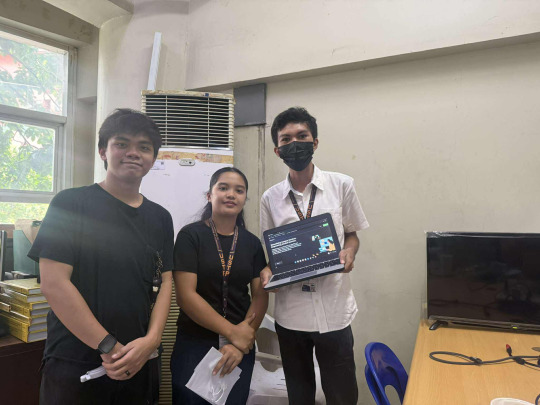
1 note
·
View note
Link
Object-oriented programming (OOP) is one of the pillars of modern software engineering. Born to tackle increasing software complexity, OOP languages i...
#Objectorientedprogramming#OOPlanguages#Java#Python#C#Programmingparadigms#ProsandconsofOOP#Softwaredesign#Modularity#Inheritance#Functionalprogramming
0 notes
Text
"Working Effectively with Legacy Code" by Michael C. Feathers is a must-read for developers and software engineers who deal with legacy systems. Legacy code, often characterized by its complexity, lack of documentation, and resistance to change, can be daunting to work with. This book provides practical strategies and techniques to understand, refactor, and improve legacy codebases. Below is a user-friendly, step-by-step breakdown of the key outcomes and takeaways from the book.
#LegacyCode#Refactoring#SoftwareDevelopment#CleanCode#CodeRefactoring#TechBooks#SoftwareEngineering#WorkingWithLegacyCode#MichaelFeathers#LegacySystems#CodeQuality#TechTutorial#SoftwareMaintenance#DevelopmentBestPractices#TechEducation#SoftwareCraftsmanship#LegacyCodeTips#RefactorLegacyCode#ProgrammingBooks#TestDrivenDevelopment#AgileDevelopment#SoftwareDesign#TechLeadership#ProgrammingBestPractices#DeveloperTools#TechCommunity
0 notes
Text
Empowering Nurses Through Technology: The Role of Hospital Kiosks on Nurses Day

Nurses Day is more than a celebration — it's a tribute to the tireless dedication, compassion and skill that nurses bring to healthcare every day. As we recognize these frontline heroes, it’s important to spotlight the tools that support their work and enhance patient care. Hospital kiosks, powered by modern technology are revolutionizing the healthcare environment. By automating administrative tasks and streamlining operations, these self-service systems enable nurses to focus more on what matters most: delivering quality care to patients.
The Importance of Nurses Day in Healthcare
History and Significance of Nurses Day
Nurses Day is celebrated globally on May 12th, marking the birth anniversary of Florence Nightingale, the pioneer of modern nursing. This day is dedicated to acknowledging the critical role nurses play in safeguarding public health. From managing emergencies to providing emotional support, nurses are the backbone of the medical field. Nurses Day serves to honor their relentless service, highlight their contributions and promote the value of nursing as a profession.
Recognizing Nursing Excellence and Challenges
While nurses are celebrated for their compassionate care and clinical expertise, they often face considerable challenges — long hours, administrative overload and emotional fatigue. Recognizing these hurdles on Nurses Day brings attention to the need for systemic support. Technological tools, such as hospital kiosks, have emerged as practical solutions to reduce burdens and create more efficient healthcare environments.
Introduction to Hospital Kiosks in Modern Healthcare
Types of Hospital Kiosks and Their Features
Hospital kiosks are self-service terminals designed to streamline various healthcare services. Common types include:
Patient Check-In Kiosks: Allow patients to register upon arrival, verify insurance and update personal information.
Information Kiosks: Provide directions, hospital maps, department details and answers to frequently asked questions.
Self-Service Payment Kiosks: Enable bill payments via card, mobile wallets or cash, reducing queue times.
Prescription Refill Kiosks: Allow patients to request refills or schedule pharmacy pickups. Each kiosk type is equipped with user-friendly interfaces, multilingual support and secure data handling mechanisms.
Technological Advancements Enabling Smarter Healthcare
Advances in touchscreen technology, biometric authentication, cloud integration and artificial intelligence have made hospital kiosks more responsive and accessible. These kiosks now support features like facial recognition, electronic signatures and real-time data syncing with hospital management systems. These capabilities not only improve patient experience but also strengthen backend workflows that support nursing staff.
How Hospital Kiosks Support Nursing Excellence
Reducing Administrative Burden on Nurses
One of the most significant benefits of kiosks is the automation of routine administrative tasks. Patient check-in, consent form submissions and data entry can now be handled at kiosks.This reduces paperwork for nurses, allowing them to allocate more time to clinical assessments, care planning and patient interaction.
Improving Patient Engagement and Communication
Kiosks empower patients by providing clear,consistent information about their appointments, medications and treatment plans. Nurses benefit from this improved communication, as patients arrive better informed and more prepared for consultations. This results in smoother interactions and enhanced trust in care delivery.
Enhancing Accuracy and Efficiency in Data Management
Kiosks minimize human error by standardizing data input processes. They ensure that information such as patient history, allergies and insurance details is accurately captured and integrated into the hospital’s electronic health records (EHR). Nurses can then access complete up-to-date information without the need for redundant data collection.
Real-World Examples of Kiosk Integration Improving Nursing Practice
Case Study: Self-Service Check-In Kiosks in Urban Hospitals
Hospitals in major cities have successfully implemented self-service check-in kiosks to streamline patient flow. For instance, in a multi-specialty hospital in Dubai, kiosks reduced check-in times by 60% and freed up nurses to focus more on patient rounds and critical care. The result was improved patient satisfaction and reduced nurse burnout.
Innovative Uses of Kiosks for Nurse Training and Support
Some hospitals are using kiosks as resource hubs for nursing staff. These systems offer access to training modules, digital manuals and emergency protocols. Nurses can use them to refresh skills, access decision support tools or submit internal reports—all without needing a desktop computer or additional paperwork.
Future Trends: Expanding the Role of Hospital Kiosks in Nursing Care
Integration with AI and Telehealth Services
AI-integrated kiosks are beginning to offer symptom checking, health assessments and triage assistance. These capabilities help nurses prioritize cases and allocate resources more effectively. In telehealth settings, kiosks may serve as virtual consultation points, allowing nurses to assist with remote diagnostics and follow-up care.
Personalized Patient Interaction and Data Analytics
Data analytics embedded in kiosks can track patient behavior, preferences and health patterns. Nurses can use this data to personalize care plans, identify at-risk patients and proactively manage chronic conditions. Predictive analytics also assist in staffing and scheduling, ensuring optimal nurse-to-patient ratios.
Conclusion
On this Nurses Day, it’s essential to celebrate not only the dedication of nurses but also the innovations that uplift their work. Hospital kiosks exemplify how technology can enhance care delivery, reduce workload and create a more responsive healthcare system. By investing in intelligent tools that support nurses, healthcare institutions are building a future where quality care and efficiency go hand in hand.
1 note
·
View note
Text
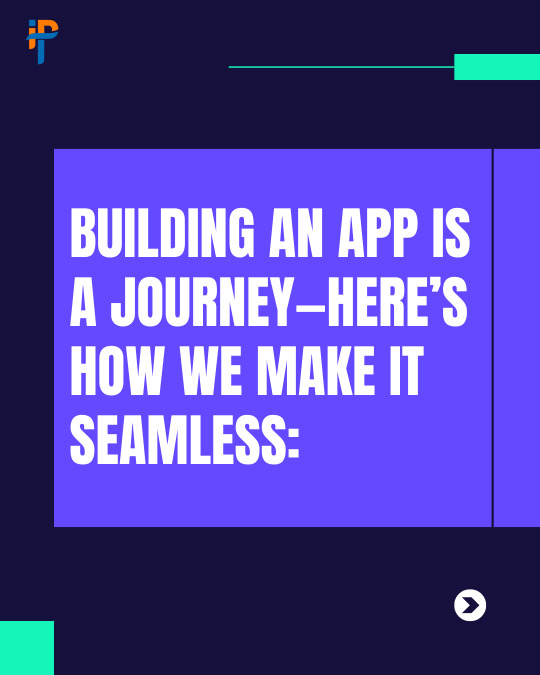
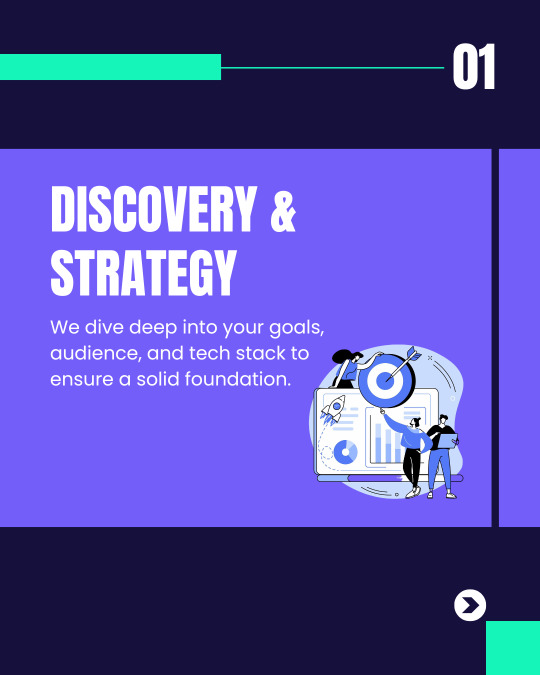

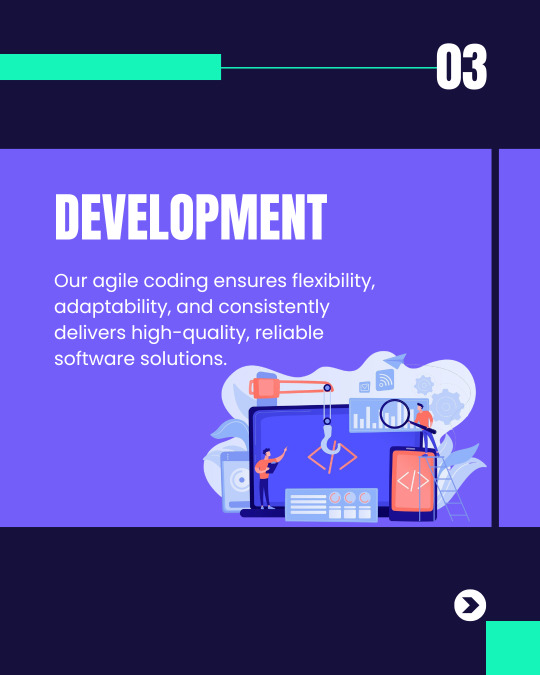
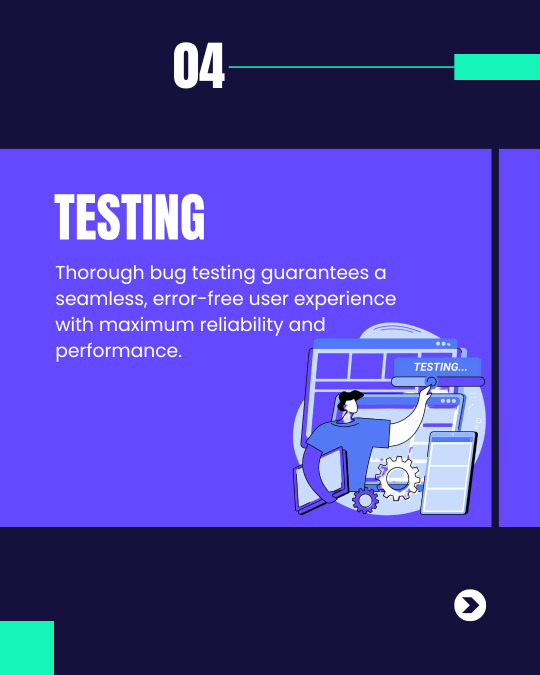
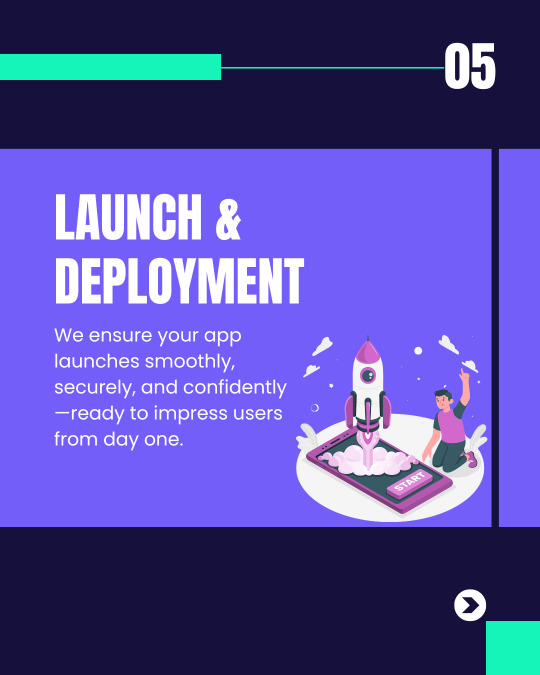
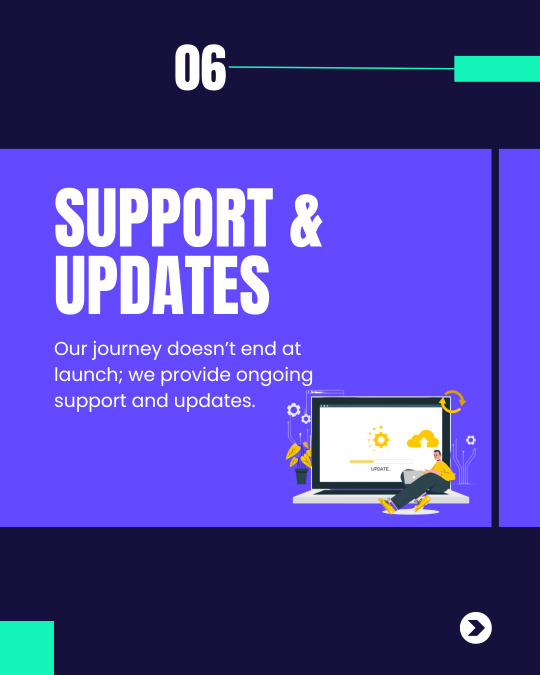
6 Steps to Build Your Dream App 🛠️ 📱 From Concept to Launch: How We Build Apps That Win! See how we turn ideas into reality! Ready to start your journey? Let’s chat! 💬
Visit - https://iphtechnologies.com/?utm_source=social&utm_medium=+&utm_campaign=social
1 note
·
View note
Text
Accelerate Your Business Growth with Digital Transformation Services

In today’s fast-changing world, businesses need to adapt and evolve with technology. At Tech Mind Developers, we offer Digital Transformation Services to help companies modernize, improve efficiency, and stay ahead in the competitive market. Whether you are a startup or an established business, upgrading to digital solutions can enhance productivity and customer experience.
Why Digital Transformation is Important?
Digital transformation is the process of using modern technology to improve business operations and customer engagement. Here’s why businesses need it:
Boost Efficiency: Automate tasks and reduce manual work.
Enhance Customer Experience: Offer faster and better services.
Increase Business Growth: Reach more customers and expand online.
Data-Driven Decisions: Get insights for better business strategies.
Competitive Advantage: Stay ahead with the latest digital tools.
Our Digital Transformation Services
At Tech Mind Developers, we provide customized solutions to meet your business needs:
Website & Mobile App Development — Build responsive and user-friendly platforms.
Cloud Solutions — Secure and scalable cloud-based services for smooth operations.
E-commerce Development — Launch a strong online store to increase sales.
Business Automation Software — Automate processes to improve productivity.
AI & Data Analytics — Use AI-powered tools for better decision-making.
Why Choose Tech Mind Developers?
Experienced Team: Our skilled professionals understand business needs.
Custom Solutions: We provide tailored digital services for every industry.
Affordable Pricing: High-quality solutions at the best price.
Client Satisfaction: We focus on long-term partnerships and trust.
Contact Us
Ready to transform your business? Let’s discuss how Tech Mind Developers can help.
📞 Phone: +91–7835019421 📧 Email: [email protected] 🌐 Website: https://www.techminddevelopers.com
#digitaltransformationservices #techminddevelopers #businessgrowth #digitalbusiness #automation #cloudsolutions #ecommercedevelopment #aiandanalytics #besttechcompany #softwaredevelopment #itservices #topsoftwarecompany #customsolutions #affordabletech #businessautomation #futuretechnology
#digitaltransformationservices#techminddevelopers#businessgrowth#digitalbusiness#automation#cloudsolutions#ecommercedevelopment#aiandanalytics#besttechcompany#softwaredevelopment#itservices#topsoftwarecompany#customsolutions#affordabletech#businessautomation#futuretechnology#mobile app development#softwaredesign#websitedevelopment#delhincr#mobileapplications#softwaresolutions#aligarh
0 notes
Text
https://www.thefullstack.co.in/software-design-patterns/

#SoftwareDesign#DesignPatterns#ProgrammingTutorial#CodeArchitecture#SoftwareEngineering#CodingTips#LearnToCode#DevCommunity#CleanCode#OOP (Object-Oriented Programming)#SOLIDPrinciples
0 notes
Text
CPE312 Software Design and Engineering
App Presentation + Exam Exemption (Finals)
Week 16
December 17-18, 2024
ִֶָ𓂃 ࣪˖ ִֶָ🐇་༘࿐
Today was the big day—our final presentation for EduConnect TutorHub. Sir Carl told us that if we met 100% of the requirements, we’d get a perfect score, which motivated us to stay up all night finishing both the app and the paperwork. Early this morning, we gathered at the 4th floor of the CEA building to revise and finalize everything. When it was our turn, our leader introduced the app and its functionality, while I presented the documentation. After the presentation, Sir Carl pointed out some needed revisions, so we planned to fix everything and return the next day.
Later that night, Sir Carl messaged our group chat and announced that we were exempted from the finals exam as long as we submitted all requirements within the week. We were so happy—thank you, Sir Carl!


The next day, we worked hard to complete everything. Our leader prepared screenshots for white-box and black-box testing, another teammate edited the user manual brochure and tutorial video, and I updated Chapter 4 to show the app’s 100% success rate. In Chapter 5, we concluded that the app is fully functional and ready for deployment, with recommendations for future improvements. We also tested its performance on multiple devices, showing that it worked smoothly without errors.
For the System Usability Scale (SUS), Sir Carl asked us to survey more respondents to ensure accurate results. We immediately conducted surveys with classmates and managed to get a 90+ SUS score, earning an A+ rating with the best imaginable ranking. After all the revisions and the final presentation, Sir Carl gave us a perfect 100%. We were relieved and proud to have completed everything on time and secured exam exemption.


This project had its challenges—stressful moments, arguments, and sleepless nights—but we pulled through as a team. I’m grateful to Sir Carl for his guidance, which helped turn our ideas into reality. This feels like a huge milestone for me as a 3rd-year Computer Engineering student. With that, we, the team of EduConnect TutorHub, are signing off. Good night!






𓂃 ࣪˖ ִֶָ🐇་༘࿐
#SDE#3rdYear#SoftwareDesign#FinalPresentation#Exempted#100%#ComputerEngineering#CPE3C#EduConnectTutorHub
1 note
·
View note
Text
Software Architecture Patterns: An In-Depth Guide for Developers

Latest News
News
Stock Market Update: Nifty 50 Movement, Trade Setup, and Top Stock Picks
News
Markets on Edge: Indian Indices Dip, Bitcoin Hits Record, and Global Trends Shape the Week Ahead
News
BlueStone Jewellery Plans ₹1,000 Crore IPO with Fresh Issue and OFS
Source: deazy.com
In the fast-evolving world of software development, understanding the software architecture patterns is crucial for building robust, scalable, and maintainable applications. With the growing demand for complex systems in India’s tech landscape, developers must be well-versed in various architectural patterns to meet the diverse needs of their projects. This article will explore the essential software architecture patterns, their characteristics, advantages, and use cases, helping developers make informed decisions in their projects.
What Are Software Architecture Patterns?
Software architecture patterns are standardized solutions to common software design problems. They provide a framework that guides developers in structuring their applications, ensuring better organization, scalability, and maintainability. By employing these patterns, developers can avoid pitfalls associated with software design and improve their overall development workflow.
In India, where software development is a booming industry, especially in cities like Bengaluru and Hyderabad, a solid understanding of software architecture patterns is essential for both new and experienced developers.
Common Software Architecture Patterns
1. Layered Architecture
https://businessviewpointmagazine.com/wp-content/uploads/2024/11/34.1-Layered-Architecture-Source-apisec.ai_.jpg
The layered architecture pattern divides the application into distinct layers, each responsible for specific functionalities. Typically, these layers include:
Presentation Layer: The user interface components.
Business Logic Layer: The core functionalities and rules of the application.
Data Access Layer: The layer that handles data retrieval and storage.
Advantages:
Separation of Concerns: Each layer has a specific responsibility, making it easier to manage and modify.
Testability: Layers can be tested independently, enhancing the quality of the code.
Use Cases:
This pattern is ideal for enterprise applications where different teams can work on different layers simultaneously.
2. Microservices Architecture
Microservices architecture is an approach where applications are developed as a collection of small, independently deployable services. Each service is responsible for a specific business capability and communicates with others through APIs.
Advantages:
Scalability: Services can be scaled independently based on demand.
Flexibility: Developers can use different technologies and programming languages for different services.
Use Cases:
This pattern is gaining traction among startups and large enterprises in India, especially those looking to innovate rapidly and scale their applications seamlessly.
3. Event-Driven Architecture
https://businessviewpointmagazine.com/wp-content/uploads/2024/11/34.2-Event-Driven-Architecture-Source-webvideoadspace.net_.jpg
In an event-driven architecture, the system reacts to events or changes in state, often leveraging message queues or event streams to communicate between components. This pattern is especially useful in systems that require real-time data processing.
Advantages:
Responsiveness: Systems can react to changes in real-time, improving user experience.
Decoupling: Components are loosely coupled, allowing for easier updates and modifications.
Use Cases:
This architecture is ideal for applications that need to process large volumes of data or require real-time analytics, such as financial services and e-commerce platforms in India.
4. Serverless Architecture
Serverless architecture allows developers to build applications without managing the underlying infrastructure. Instead, they rely on third-party services (like AWS Lambda) to run their code in response to events.
Advantages:
Cost-Effective: You only pay for the compute time you consume.
Focus on Code: Developers can concentrate on writing code rather than managing servers.
Use Cases:
This pattern is suitable for startups and small businesses in India aiming to minimize operational costs while maintaining agility in development.
5. Client-Server Architecture
https://businessviewpointmagazine.com/wp-content/uploads/2024/11/34.3-Client-Server-Architecture-Source-herovired.com_.jpg
The client-server architecture is a traditional model where the client (user interface) requests services from the server (data processing and storage). This architecture separates the client and server functionalities, enabling efficient resource management.
Advantages:
Scalability: The server can handle multiple client requests simultaneously.
Centralized Management: Updates and maintenance are easier as they can be handled on the server.
Use Cases:
This pattern is commonly used in web applications and online services, making it relevant for various industries in India, including finance and healthcare.
Choosing the Right Software Architecture Pattern
Selecting the appropriate software architecture pattern for your project depends on various factors, including:
Project Requirements: Understand the functional and non-functional requirements of your application.
Team Structure: Consider the skills and expertise of your development team.
Future Scalability: Choose a pattern that allows for growth and scalability based on anticipated changes.
Conclusion
As the software development landscape continues to evolve, mastering various software architecture patterns is essential for developers, particularly in a rapidly growing market like India. By understanding these patterns, developers can make informed decisions that lead to more efficient, maintainable, and scalable applications. Whether you opt for a layered architecture, microservices, event-driven, serverless, or client-server architecture, knowing the advantages and use cases will equip you with the tools to succeed in your software development journey.
Incorporating the right software architecture patterns will not only enhance your application’s performance but also ensure a smoother development process, ultimately contributing to a better user experience. Embrace these architectural principles, and watch your software projects flourish in today’s competitive landscape.
Did you find this article helpful? Visit more of our blogs! Business Viewpoint Magazine
#softwaredeveloper#softwareengineer#softwaredesign#softwaretesting#softwaresolutions#softwareengineering#softwarehouse#softwarecompany#devops#softwaredevelopers#softwaredev
0 notes